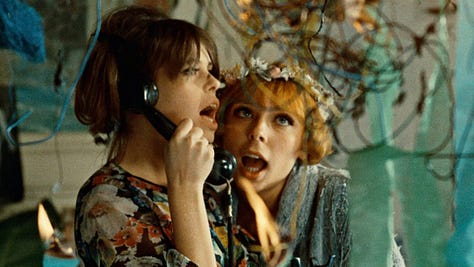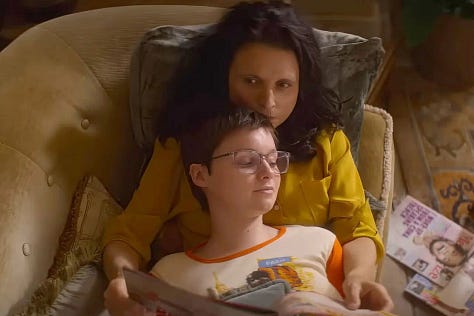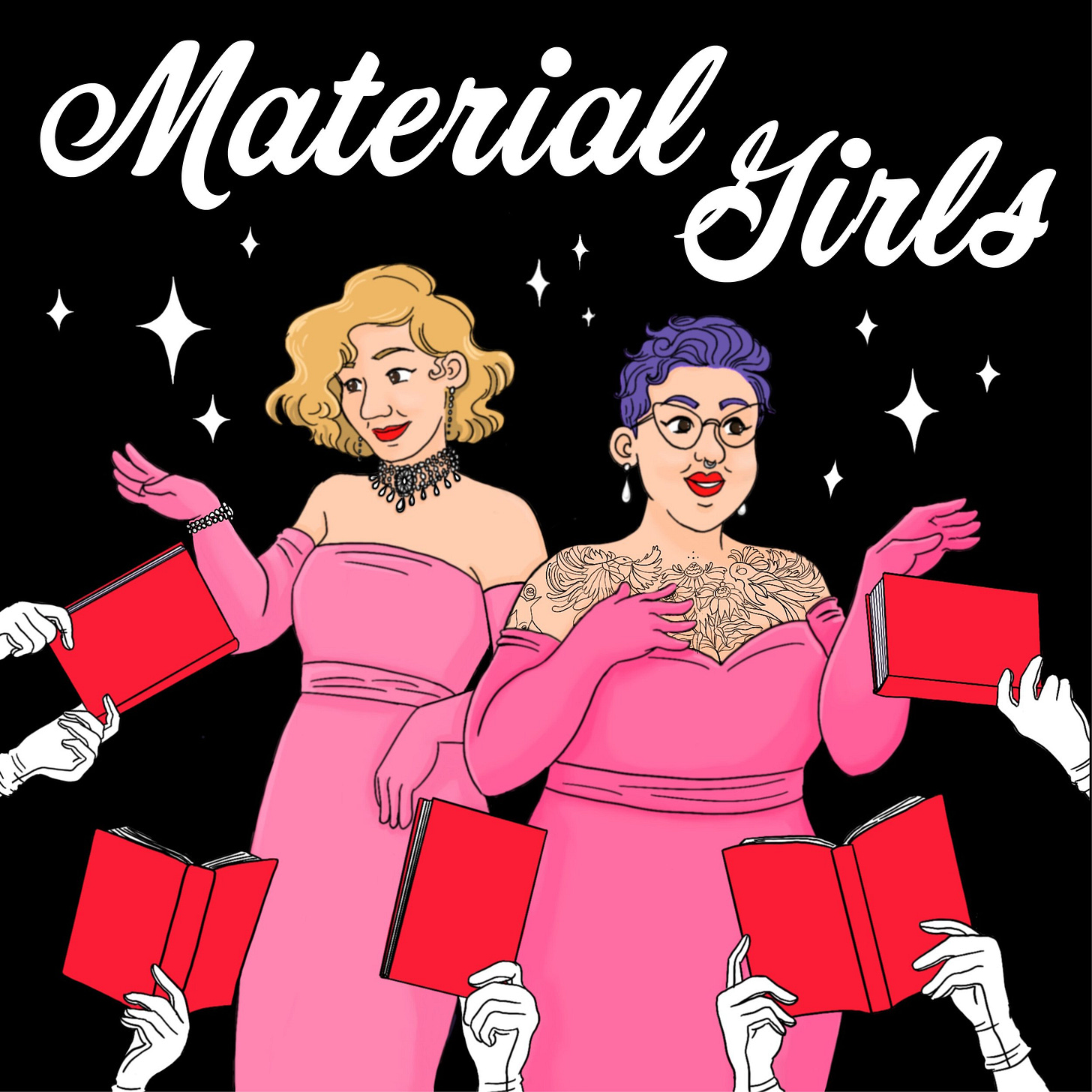Obsessed: Movies and Podcasts
A Periodic Roundup of the Things Living Rent-Free in My Head (001 — Week of July 29th)
Welcome to the first edition of Obsessed: A Periodic Roundup of the Things Living Rent-Free in My Head.
With all the caveats about overconsumption of all sorts (tl;dr: they say it’s bad—and I’m not inclined to disagree), I am a netizen who before that was chronically collecting beauty in the analog world. In other words, my head is full, brimming. And I’ve just gotta make space.
So, and with all the caveats about the iniquities of being a landlord (tl;dr: they say it’s bad—and I’m not inclined to disagree), I’ll be kicking some mental tenants, as it were, to the curb every now and again.
That is, expect a periodic recommendation-grab-bag of music, podcasts, films, shows, restaurants, swimming spots, books—what have you. That is, the things I’ve collected along the way; things that I’ve delighted in, treasure, and want to share. (Because isn’t that the fun of collecting? The communal reverie of their very existence and their being perceived?)
I was hesitant to make this a series, as I am a completist, and like to collect everything before sharing. But you can’t organize without making space. And in a certain way, this is a list of everything, for as long as I am seeking, so too shall I find more. But for the part of me that loves organized databases, I will be including a spreadsheet in each edition that will be the growing list of obsessions so you (nor I) will ever be without the complete list. (Phew!)
In this edition, fresh on the heels of a weekend away at my cinephile godparents’ home where I took long walks with Cobi accompanied by a requisite podcast, I will be sharing a few standouts in those categories: Film and Podcasts.
Films
Night of the Hunter (1955)
This is the scariest movie I have ever seen. Full stop.
But unlike other scary movies I have seen (which, admittedly are few—my tolerance for terrorizing psychological manipulation induced by a screen is low, on a scale of The Wizard of Oz (not very scary) to The Exorcist (too scary to consider watching) I don’t go above a Hitchcock—The Night of the Hunter left me feeling deeply settled emotionally and psychically at its end.
I slept fine afterward, is what I am trying to say. In fact, I felt a renewed sense of faith in humanity so much so that I’ve decided I will watch this movie on Christmas as a new tradition (obviously with no children around—oh yeah, DO NOT watch this with children).
I don’t want to give too much of the plot away. If you are interested in those kinds of things, Google it. What I will say is this: The Night of the Hunter is deeply precise, beautiful, and compelling in everything from its soundtrack to its set design to the acting.
Across its 189-minute run time, I pulled a blanket over my head in fear and cried sweet tears of resolution. I found it incredibly gratifying, I felt lucky to have watched it (at the nudging of my godparents, I would have never dared otherwise—“Trust us, you’ll love it,” they said, they were not wrong).
You’ll also love it if you also obsess over: lighting, architectural section diagrams, (hand) tattoos, evangelicalism, (minimalist) soundtracks, implied social commentary, traditional American hymnody, or bear vs. man.



Daisies (1966)
First, this movie is beautiful and bright. It centers on the hijinks of two women, Marie I and Marie II, who embody girlhood in all its rebellious splendor.
I can’t say enough good things about how incredibly delicious this movie is to watch. It is saturated, and fun. It feels like you can almost step into the screen and join them as they take bubble baths, lounge with their curlers on, jump on furniture, make prank phone calls, eat cake, swing from chandeliers, you know, girly pop things.
I watched it for the first time on a couch next to my best friend. In this context, Daisies felt like a ride at an amusement park made bespoke for our pleasure. It was as if she and I were also seated side-by-side on a banquette, embarking on a surreal and anarchic journey in response to a world we, too, find absurd.
Second, this movie reinforces the notion of girlhood as radical and political—a tenet to which I, also, subscribe.
This film is famous for the stir it caused in 1960s Czechoslovakia when the film was filmed and released during a period of political transition. In an attempt to evade censorship, as well as for artistic merit alone, the film uses allegory and novel editing to enact social critique.
Apparently, this artistic limb was not received well at the time by film critics at the New York Times, who disparaged the duo as “thoroughly empty-headed” and the film as “pretentiously kookie.” (The most familiar insults for women in the book.)
The Criterion Collection’s essay on the movie comes to the defense of the Maries’ ditz, noting that “under patriarchal and totalitarian oppression, clearing one’s own mind can be a radical act of deprogramming.” And I must agree. This movie appeared to be as carefree for the actors as it is for the viewer. And this is, in itself, a radical act. But their analysis misses what I think is the important rendering of the permission that normative ideas about girls and girlhood afford women and girls in being authentically joyous in their politically-aimed subversion.
In other words, Marie I and II, just like any girlhood duo dreaming of a more equitable and flourishing world, are not de-programming as the Criterion Collection suggests, but re-programming. That is, imagining what could be that isn’t already (cc: radical speculative futures).
This movie, or at least my viewing of it reinforces the idea that: ‘because they are girly they slip below the radar,’ and challenges the idea that: ‘because they are girly in their ditz they couldn’t possibly also be enacting intentional subversion.’
Because, oh, but they could. And they do.
In their antics, from food fights to wanton destruction of property, are a vibrant rejection of the restrictive roles imposed on them. And through the portrayal of their play, the film showcases the power of joy and absurdity as tools of resistance.
You’ll also love it if you obsess over: refined coloring, 1960s women’s hairstyles, girlhood, (the futility of) embodying political resistance, maximalism, or giggling.



Tuesday (2023)
Let me start by saying, I typically would run from the theatre if someone told me the story revolved around a CGI mackaw that spoke in a grizzly voice and was called, Death. And I won’t judge you if you stop reading this reccomendation now that you know that.
The thing is, I didn’t.
See, one of the things I love most about going to the movies is not watching the trailer nor reading the synopsis beforehand. I’ll avoid even looking at the poster if I can help it. This way, I am a blank slate. And I either like the movie or I don’t. But I am not burdened by a preconceived notion I had of what the film would be.
In the case of Tuesday, this meant the difference between seeing and never seeing this movie. (And, well, because it’s on this list, you know the seeing of it was worth it.)
Unlike the other two films in this list, the visuals were good, but not what made the film exceptional. (If anything, it was the CGI’s capacity to inject an element of the fantastical, whether you want to call it fairy tale or magical realism -like, that really is where the aesthetic wow factor lay.)
Rather, and despite (or because of) one of the main characters, Death, being animated, this movie was deeply moving and sentimental. Heartwrenchilgly so.
I have experienced a lot of death in my life and can say few portraits have felt so completely familiar with the experience of losing as Tuesday did. Familiar with its poetry, and tragedy, and fury, and surreality. Familiar with the refusal and acceptance that are at play when losing someone, or losing yourself. And with the performance of competence, with the ‘it-will-be-alright,’ when it both will and won’t.
I also have experience being a daughter to a mother. Of being in that dynamic when death was imminent. Tuesday was the first time I saw or read scenes about death that felt so specifically snatched from my own life. How even amongst the saddest and scariest near-future when one of you will no longer be around, the banality of everyday life plays alongside the raised emotions of the imminence of “death,” both canonical to a life where love is abundant and absent in life once one dies.
You’ll also love it if you obsess over: the importance of end-of-life and death doulas, Grief is the Thing With Feathers, motherhood, daughterhood, London (especially in a zombie apocalypse-type scenario), or Ice Cube’s ‘It Was A Good Day.’



Podcasts
Tech Won’t Save Us (hosted by: Paris Marxx)
“Tech Won’t Save Us weeds through the crap and snake oil of the industry and discusses the human consequences of technology.” - Gizmodo
I have had a bizarre career through tech, reminiscent of Anna Wiener’s memoir Uncanny Valley. Through a techno optimist-libertarian adjacent belief perpetuated that the tech will save us by colleagues and a city of origin that revered the likes of the Long Now Foundation, and then back through the beliefs perpetuated by my family of origin (and common sense), that no, in fact, tech will not save us.
(Why I still work and will continue to work passionately in tech is a story of seeing something else in tech besides a binary savior or lack thereof: a material.)
Tech Won’t Save Us is hosted by the Canadian Author Paris Marxx, who has a lovely Canadian lilt and spacious interviewing style that lets his guests do 90% of the talking, making each episode like a miny lecture signposted with expansive questions posed by Marxx. In addition, scrolling through the guests is a good way to find journalists to follow on X for a critical take on big tech’s chokehold on, well, everything.
You’ll also love it if you obsess over: if and when the robots are going to take over, why self-driving cars will never work, infrastructure, or the Canadian ‘about.’
If you only listen to one episode (and it’s before the 2024 presidential election), let it be this one where Jacob Silverman walks us through the entanglement between the Valley and the Republican party. Did you know the largest donor to the Trump campaign is a crypto super PAC? Here is where I found out:
If you live in the Bay Area and want to know more about the investments in undermining the democratic process through land acquisition and how this, too, is entangled with the Valley’s East Solano Plan, this interview with Gil Duran is your episode.
And if either A) you weren’t able to make it through Malcolm Harris’ book Palo Alto (I tried, and still plan on it, so much good info, but I wasn’t in love with the editing) and/or B) you’ve always thought Stewart Brand was a stand-up guy (turns out, he wasn’t), you’ll appreciate this relatively compact episode with Harris.
Material Girls (hosted by Hannah McGregor and Marcelle Kosman)
“Every episode you'll get your pop culture fix with some academic theory added to the mix. Join feminist scholars … for episodic dives into the zeitgeist. Together they ask the materialist question ‘why this, why now?’ about books that are on everyone's nightstands, songs that are on rotation, movies that have captured Twitter discourse — and so much more.”
As an academic who thinks critically (in the critical theory sense) about things and unabashedly loves many vestiges of consumption culture (from bedding to media), when I first encountered this podcast it gave me strong ‘why didn’t I think about that?’ energy.
The premise is this: after Hannah McGregor and Marcelle Kosman, PhD set up the topic for the show, be that Tupperware or Gilmore Girls, they introduce academic theory they will use to query their object of study. At the end of the episode, they pitch a thesis statement that they posit sums up their analysis and then spend a bit of time critiquing that thesis before rounding up with the inevitable incompleteness of an academic examination: remaining questions.
You’ll also love it if you obsess over: critical theory, (pop) culture, demystifying academese, You’re Wrong About being post it’s pandemic heyday, or Sounds Like a Cult always leaving you wanting more.
If you’ve ever thought cafe lights and a spacious backyard would fix all your problems (guilty, also, not entirely ineffective), you’ve probably been (willingly) brainwashed by ‘Normporn’ found in the likes of Gilmore Girls and Parenthood. I can’t tell you how much I liked this episode, it might be my favorite podcast episode of 2024.
If you play or wish you played Dungeouns and Dragons (me! HMU if you want to form a guild!) this episode takes us through how it came to be positioned culturally (and I would argue) aesthetically, as something for boys in basements:
And if you want to brush up on what the heck ‘neoliberalism’ or a ‘materialist critique’ really is, and/or have asked yourself who is profiting from the rise of non-toxic masculinity, and/or watch Queer Eye, listen to this:
With that, happy consuming, more still to come,








